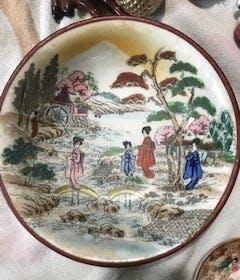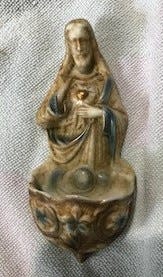John Sikorski: Plates, bowls would sell below $10

Q: I saw your information in the newspaper. We have inherited several hand-painted plates, bowls, etc., from occupied Japan.
I also have holy water holders from Germany. We are thinking about selling them; however, we do not know what they are worth or where we could sell them. Any help would be appreciated. Thank you. — C.P., Internet

A: The plates and bowls marked “occupied Japan” were made in Japan from the end of World War II for seven years while the U.S. occupied Japan. While Japan was rebuilding their economy, all export products had to be marked “occupied Japan” or “made in occupied Japan.” The collecting category is called “occupied Japan.” Most plates, bowls, cups and saucers, etc., sell below $10 each.
The porcelain holy water figural wall pockets marked “Germany” were likely made before World War I. There is no specific collector interest. Potential dollar value is $15 to $30 each.
Q: I am hoping you can give me some information on the history and value of a doll I have. It came down through the family, and I do not know anything about her. She is 28 inches tall, has a porcelain face with eyes that open and shut, and a painted open mouth with teeth. I am pretty sure her blonde wig is real hair. All of the joints move, and even her wrists have movement. On the back of her neck is a red stamp that reads “Excelsior” inside a rectangle, “D.R.P. No 70685, Germany, 6.” I have been told the doll maker was JD Kestner. She is in good condition and being kept in storage up north. I am interested in selling the doll. Thank you for anything you can tell me. — M.C., Internet
A: The Kestner Doll Company was in business in Germany from the early 19th century until the 1920s. They are considered one of the quality makers of dolls by doll collectors. I think your doll was made circa 1900. Prices have declined considerably on dolls since the late 20th century. I think it would be best not to sell your doll now as I suspect prices will likely go back up in the near future. If you are determined to sell the doll, I suggest you contact doll aficionado Sherry Minton. The phone number is 407-293-3164.
— John Sikorski, with more than 35 years of experience, is an Ocala-based antiques advisor, consultant and broker. Send your questions to Sikorski's Attic, c/o The Ocala Star-Banner, 2121 SW 19th Ave. Road, Ocala, FL 34471-7752, or email absantique@aol.com.
This article originally appeared on The Gainesville Sun: John Sikorski: Plates, bowls would sell below $10
